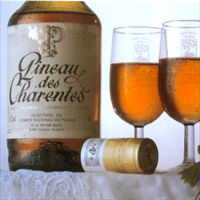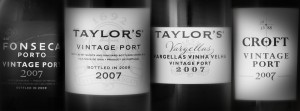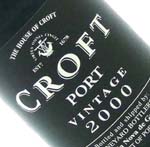 A few weeks ago I stumbled upon a rare treat in the larger wine world, particularly here in North America: Pineau des Charentes. When I saw that Joe the #1 Wine Dude had expanded this month's Wine Blogging Wednesday theme (maderized dessert wines) to include fortified wines, well, it was all I could do to hold off all reports on this fabulous little dessert/aperitif-perfect-for-apple-pie-or-in-front-of-the-fire-or-before-a-chic-meal find!
Pineau des Charetes is made from 2/3 unfermented must of fresh grapes and (drum roll please!) 1/3 COGNAC. This is my paradise.
A few weeks ago I stumbled upon a rare treat in the larger wine world, particularly here in North America: Pineau des Charentes. When I saw that Joe the #1 Wine Dude had expanded this month's Wine Blogging Wednesday theme (maderized dessert wines) to include fortified wines, well, it was all I could do to hold off all reports on this fabulous little dessert/aperitif-perfect-for-apple-pie-or-in-front-of-the-fire-or-before-a-chic-meal find!
Pineau des Charetes is made from 2/3 unfermented must of fresh grapes and (drum roll please!) 1/3 COGNAC. This is my paradise.
Old wives tales (or perhaps actual history) has it this fun beverage was created by mistake. How so? Well, apparently a grower back in the 16th Century poured grape must (the juice, skins, stems...) into a barrel that already contained Cognac (brandy). The barrel was out of sight/mind for another 5 years or so until a huge harvest came in and additional barrels were needed. Soon enough, the concoction was discovered. The stuff tasted so darn good - fruity, sweet, yet lighter and not cloying in texture - the folks in Charentes, France perfected the process and began peddling it to eager consumers.
This aperitif thrills me for a number of reasons. First, it is a rare find here in the United States. Somehow, the masses have failed to catch on to the glory that is this sweet, little libation. Second, most producers have not chosen to make Pineau, considering it a mere byproduct of Cognac; they simply use Ugni Blanc grapes, which is also used in the production of Cognac. Among those who do make Pineau part of their repertoire, the best wines are made from the freshest (read: from field to barrel in a single day), hand-picked grapes. Only by hand-picking can they know the moment when full maturity is acheived, when the golden grapes turn to a deep topaz color and, for the red wines, when the black grapes turn from crimson to brown.
Pineau des Charentes is often found at 18% alcohol - the optimal level. It must remain in bottle for at least one year before it is sold (and often the best producers wait as much as five years before releasing it). As I alluded above, Pineau is offered in Or (white) or Ruby (red) varieties. In the case of the Ruby, Cabernet, Cab Franc or Merlot varietals are used.
If you've never enjoyed Pineau before or after a meal, please do. You are missing out! For those who don't prefer overly sweet dessert wines, this should be a good fit. Pineau certainly can accompany a little pastry, tart, or ice cream dessert. But it is also delightful with foie gras, oysters, poached fish, goat cheese, Roquefort and even fine game. (Use your gut instinct on which - red or white - variety pairs best with each of these suggestions.) Just avoid consuming Pineau with any 'strong' flavored sauces or dishes, even as simple as olives. It'll taste a little funkity funk....
For Wine Blogging Wednesday I served the Domaine du Perat Or with apple pie two weeks ago. The fruits in the Perat were reminiscent of stewed peaches and ripe apricots. But it also offered a depth of flavors you'll find reminiscent of cognac (burnt caramel nuttiness) - without the burn. Serve chilled, for optimal flavors.
I'm curious how well received Pineau still is in France these days... do you know? If you're from North America, is this post a throw back to days of old for you? Or is Pineau de Charentes a new one on you?
 Today we're concluding our series on Port in the only really appropriate way, by ringing the bell on the official Port "showdown". LBVs and Vintage Ports are no doubt the two Port styles that most confuse consumers. Here's a tip: if you don't get caught up in the semantics of LBVs you'll be better off! Pop on over to Wicked Local today to get the full scoop to navigating these two lovely beasts with greater ease.
(Today's image is c/o 2007 Vintage Port, which also provides more info about the latest vintage to be declared.)
Today we're concluding our series on Port in the only really appropriate way, by ringing the bell on the official Port "showdown". LBVs and Vintage Ports are no doubt the two Port styles that most confuse consumers. Here's a tip: if you don't get caught up in the semantics of LBVs you'll be better off! Pop on over to Wicked Local today to get the full scoop to navigating these two lovely beasts with greater ease.
(Today's image is c/o 2007 Vintage Port, which also provides more info about the latest vintage to be declared.)

 Gearing up for a terrific Fourth of July holiday? Already know which grill wines you'll be pouring? Great! Because this year we've got something a little different for you to add to that case of wine you're taking away with you....
Hop on over to
Gearing up for a terrific Fourth of July holiday? Already know which grill wines you'll be pouring? Great! Because this year we've got something a little different for you to add to that case of wine you're taking away with you....
Hop on over to  Yeah, yeah, it may be sort of, kind of getting warmer out there here in New England. But it is still rainy, damp, brisk and windy, too. It is way too early to forget about the wonderful world of Port! This week, in fact, just in case dreams of dry rose, picnics with bubbly, or vibrant whites are on the brain, the folks in Portugal are bringing us back to reality.
For the
Yeah, yeah, it may be sort of, kind of getting warmer out there here in New England. But it is still rainy, damp, brisk and windy, too. It is way too early to forget about the wonderful world of Port! This week, in fact, just in case dreams of dry rose, picnics with bubbly, or vibrant whites are on the brain, the folks in Portugal are bringing us back to reality.
For the  A few weeks ago I stumbled upon a rare treat in the larger wine world, particularly here in North America: Pineau des Charentes. When I saw that
A few weeks ago I stumbled upon a rare treat in the larger wine world, particularly here in North America: Pineau des Charentes. When I saw that